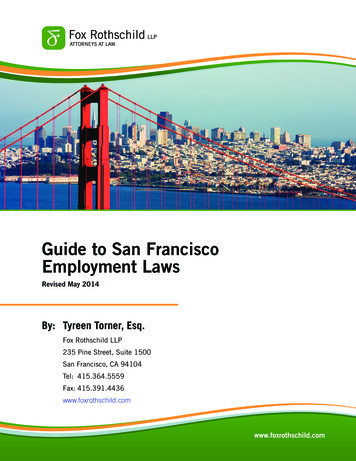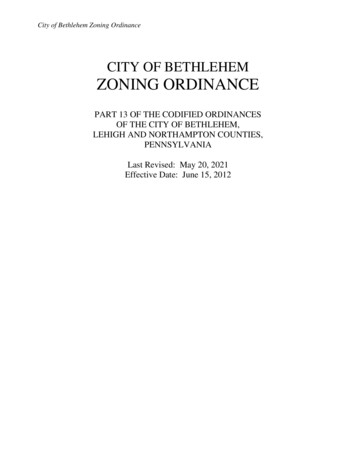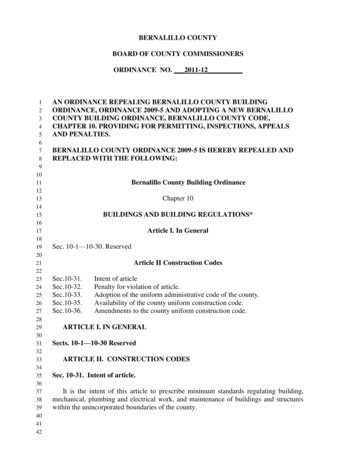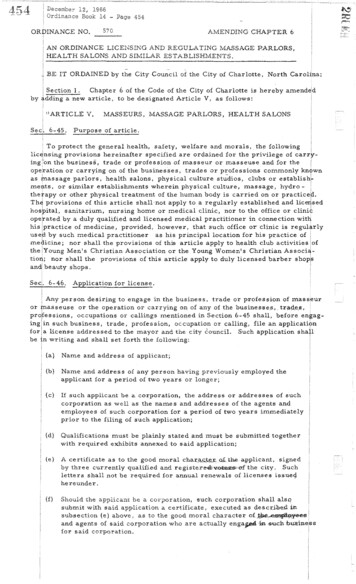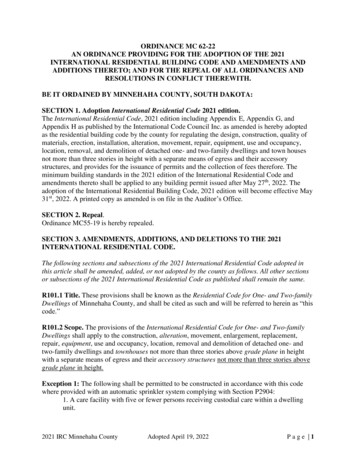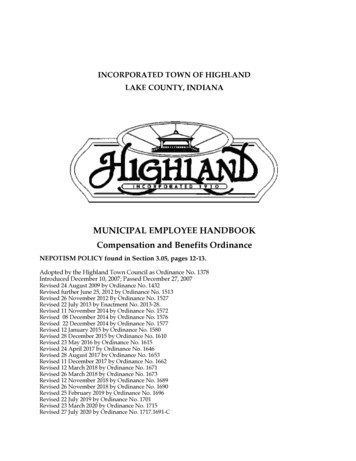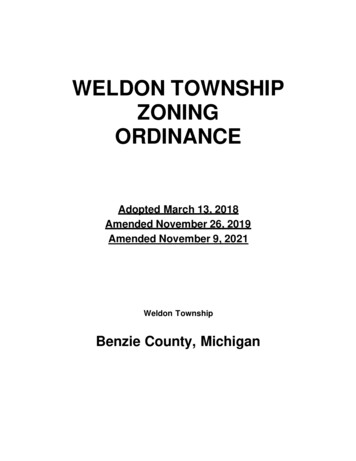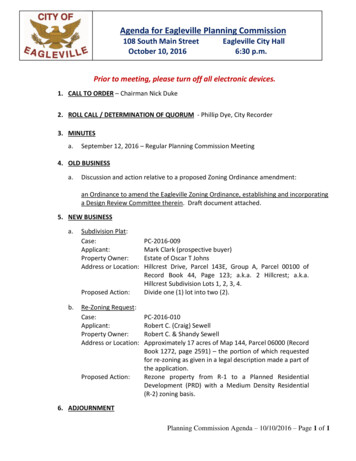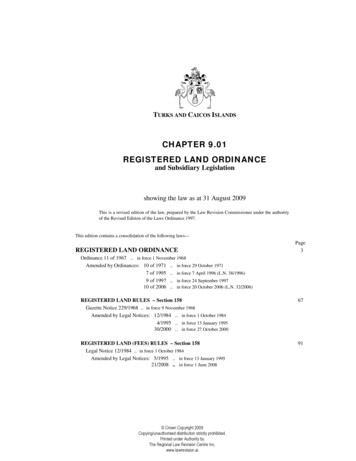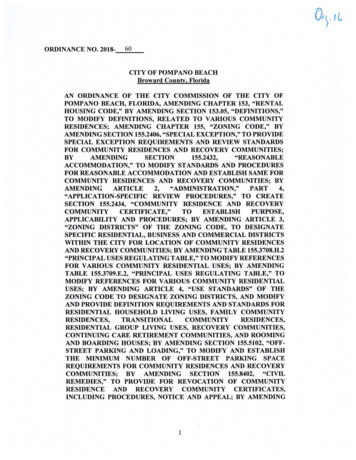
Transcription
ORDINANCE NO. 2018-60CITY OF POMPANO BEACHBroward County, FloridaAN ORDINANCE OF THE CITY COMMISSION OF THE CITY OFPOMPANO BEACH, FLORIDA, AMENDING CHAPTER 153, "RENT ALHOUSING CODE," BY AMENDING SECTION 153.05, "DEFINITIONS,"TO MODIFY DEFINITIONS, RELATED TO VARIOUS COMMUNITYRESIDENCES; AMENDING CHAPTER 155, "ZONING CODE," BYAMENDING SECTION 155.2406, "SPECIAL EXCEPTION," TO PROVIDESPECIAL EXCEPTION REQUIREMENTS AND REVIEW ST AND ARDSFOR COMMUNITY RESIDENCES AND RECOVERY CCOMMODATION," TO MODIFY STANDARDS AND PROCEDURESFOR REASONABLE ACCOMMODATION AND ESTABLISH SAME FORCOMMUNITY RESIDENCES AND RECOVERY COMMUNITIES; TION-SPECIFIC REVIEW PROCEDURES," TO CREATESECTION 155.2434, "COMMUNITY RESIDENCE AND PPLICABILITY AND PROCEDURES; BY AMENDING ARTICLE 3,"ZONING DISTRICTS" OF THE ZONING CODE, TO DESIGNATESPECIFIC RESIDENTIAL, BUSINESS AND COMMERCIAL DISTRICTSWITHIN THE CITY FOR LOCATION OF COMMUNITY RESIDENCESAND RECOVERY COMMUNITIES; BY AMENDING TABLE 155.3708.H.2"PRINCIPAL USES REGULATING TABLE," TO MODIFY REFERENCESFOR VARIO US COMMUNITY RESIDENTIAL USES; BY AMENDINGTABLE 155.3709.E.2, "PRINCIPAL USES REGULATING TABLE," TOMODIFY REFERENCES FOR VARIOUS COMMUNITY RESIDENTIALUSES; BY AMENDING ARTICLE 4, "USE ST AND ARDS" OF THEZONING CODE TO DESIGNATE ZONING DISTRICTS, AND MODIFYAND PROVIDE DEFINITION REQUIREMENTS AND STANDARDS FORRESIDENTIAL HOUSEHOLD LIVING USES, FAMILY S,RESIDENTIAL GROUP LIVING USES, RECOVERY COMMUNITIES,CONTINUING CARE RETIREMENT COMMUNITIES, AND ROOMINGAND BOARDING HOUSES; BY AMENDING SECTION 155.5102, "OFFSTREET PARKING AND LOADING," TO MODIFY AND ESTABLISHTHE MINIMUM NUMBER OF OFF-STREET PARKING SPACEREQUIREMENTS FOR COMMUNITY RESIDENCES AND RECOVERYCOMMUNITIES; BY AMENDING SECTION 155.8402, "CIVILREMEDIES," TO PROVIDE FOR REVOCATION OF COMMUNITYRESIDE CE AND RECOVERY COMMUNITY CERTIFICATES,INCLUDING PROCEDURES, NOTICE AND APPEAL; BY AMENDING1
ARTICLE 9, “DEFINITIONS AND INTERPRETATION” OF THEZONING CODE, TO MODIFY AND PROVIDE DEFINITIONS RELATINGTO DISABILITY, DWELLINGS, FAMILIES, FAMILY COMMUNITYRESIDENCES, ASSISTED LIVING FACILITIES, ALCOMMUNITY RESIDENCES AND SIMILAR USES; PROVIDING FORSEVERABILITY; PROVIDING AN EFFECTIVE DATE.WHEREAS, pursuant to Zoning Code Section § 155.2402, the Planning and Zoning Boardreviewed the proposed text amendment at a public hearing held on March 25, 2018, and voted fiveto one to recommend that the changes be approved; andWHEREAS, pursuant to Section 163.3174(4)(c), Florida Statutes, the Planning andZoning Board, sitting as the Local Planning Agency, has determined that the changes are consistentwith and further the goals, objectives and policies of the Comprehensive Plan; andWHEREAS, the City Commission of the City of Pompano Beach adopts the findings inthe Planning and Zoning Staff Report; andWHEREAS, the City Commission of the City of Pompano Beach adopts the findings andconclusions of the study it commissioned, Pompano Beach, Florida: Principles to Guide Zoningfor Community Residences for People With Disabilities dated February 2018; andWHEREAS, the City Commission of the City of Pompano Beach finds this ordinance isconsistent with the city’s Comprehensive Plan; andWHEREAS, Section 419.001 (11), Florida Statutes, establishes that “siting of communityresidential homes in areas zoned for single family shall be governed by local zoning ordinances.Nothing in this section prohibits a local government from authorizing the development ofcommunity residential homes in areas zoned for single family”; and2
WHEREAS, pursuant to Section 419.001 (12), Florida Statutes, the State of Florida allowslocal jurisdictions to adopt zoning provisions for community residences for people with disabilitiesthat are more liberal than the requirements of the state statutes; andWHEREAS, certain provisions of this ordinance do not apply if state law requires a morepermissive zoning treatment; andWHEREAS, the City of Pompano Beach recognizes that the Fair Housing Act as amended(42 U.S.C. §3601) provides protections for persons with disabilities; andWHEREAS, the Fair Housing Act does not preempt local zoning laws or preclude theadoption, amendment, or enforcement of zoning regulations by the City of Pompano Beachpursuant to its local police powers as long as the zoning regulations are consistent with state andfederal laws, including the Fair Housing Act as amended; andWHEREAS, the legislative history of the Fair Housing Amendments Act of 1988 cautionsthat local zoning regulations are prohibited that result “from false or over–protective assumptionsabout the needs of handicapped people, as well as unfounded fears of difficulties about theproblems that their tenancies may pose.” H.R. Rep. No. 711, 100th Cong. 2D Session, Reprintedin 1988 U.S.C.C.A.N. 2173, 2192 (1988); andWHEREAS, the case law under the Fair Housing Act calls for local zoning regulation ofcommunity residences for people with disabilities to use the least drastic means needed to actuallyachieve legitimate government interests; andWHEREAS, the Fair Housing Act does not provide for local land use policies or actionsthat treat groups of persons with certain disabilities differently than groups of people with otherdisabilities; and3
WHEREAS, the City of Pompano Beach commissioned a detailed study, Pompano Beach,Florida: Principles to Guide Zoning for Community Residences for People With Disabilities datedFebruary 2018 (approved and accepted by Resolution #2018-99) and revised June 2018 (approvedand accepted by Resolution #2018-178), (hereinafter, “the Study”) by a planning and law experton zoning for community residences since 1974 who has written model zoning guidelines forcommunity residences on behalf of the American Planning Association and American BarAssociation, provided consulting services on zoning for community residences to dozens ofcommunities, and served as an expert witness for the Department of Housing and UrbanDevelopment (“HUD”); andWHEREAS, the Study reports upon:The reasonable accommodation requirements the Fair Housing Amendments Actof 1988 established; andThe core nature of community residences for people with disabilities and why theyhave long been regarded to be residential uses: performing as a functional familyby emulating a biological family as a key component to achieving normalizationand community integration of their residents; andHow different types of community residences function; andThe functional differences between community residences for people withdisabilities, boarding or lodging houses, and institutional uses such as nursinghomes; andThe rational foundations for regulating community residences based on actualresearch; andA review of the research on the impacts (or lack thereof) on property values,property turnover rates, and neighborhood safety of licensed or certifiedcommunity residences for people with disabilities not clustered on a block orconcentrated in a neighborhood; andA review of the locations of all community residences throughout the City ofPompano Beach and found clustering of community residences on blocks andconcentrations in certain neighborhoods that have created or are creating de factosocial service districts in the City of Pompano Beach that interfere with the abilityof community residences for people with disabilities to achieve their core goals ofnormalization and community integration of their residents; and4
A review of the need to protect the vulnerable populations of people withdisabilities from unscrupulous operators of community residences throughlicensing, certification, or recognition by Congress; andA review of the documented abuses — including death, prostitution, fraud, andcontinued use of drugs and alcohol — people with disabilities, generally people inrecovery from drug and/or alcohol addiction, have suffered at the hands ofunscrupulous and largely unlicensed or uncertified operators of communityresidences in Pompano Beach and southeastern Florida; andAn evaluation of the current zoning treatment of community residences in PompanoBeach; andAn explanation of how multifamily buildings into which people in recovery havebeen placed, also known as “recovery communities,” recreate segregative miniinstitutions rather than function as discrete residential uses that emulate a biologicalfamily; andAn explanation of how recovery communities, especially when clustered together,reduce the opportunities for people in recovery to socialize and interact with theclean and sober neighbors who are intended to serve as role models; andAn explanation of how recovery communities clustered together alter theresidential character of a neighborhood; andA review of the limited carrying capacity of neighborhoods to absorb servicedependent people into their social structure; andEnunciation of the general principles for zoning for community residences derivedfrom the case law under the Fair Housing Act, sound zoning and planningprinciples, and factual information about the purpose and operations of suchresidences; andGuiding principles for zoning for community residences for people withdisabilities; andThe least drastic zoning approach to actually achieve legitimate governmentinterests; andA sample zoning application form to enable the city to implement the recommendedregulatory approach in a timely, but least intrusive manner; andThe limited scope of §419.001, Florida Statutes, that applies to only thosecommunity residences for people with disabilities licensed by five state agencies;and5
How §419.001(3)(c)(3), Florida Statutes, fails to comply with the nation’s FairHousing Act and lacks a factual basis; andHow community residences for people with disabilities constitute a different typeof land use than vacation rentals that warrants different zoning treatments withinthe context of the Florida Statutes; andAn annotated bibliography of representative studies of the impacts of communityresidences for people with disabilities on property values, property turnover, andneighborhood safety; andWHEREAS, clustering of community residences and/or recovery communities on a blockand concentrations of community residences and/or recovery communities in a neighborhoodundermine the ability of community residences to achieve normalization and communityintegration for their residents which are two of the essential purposes of a community residencefor people with disabilities; andWHEREAS, to implement the guidelines of the Study, the City of Pompano Beach ishereby amending its land use regulations to make the reasonable accommodations the Fair HousingAct requires by removing any terms and conditions that have the effect of limiting or makinghousing unavailable to people with disabilities while preserving the ability of communityresidences for people with disabilities to emulate a family and achieve normalization andcommunity integration of their residents; andWHEREAS, the City of Pompano Beach is amending its land use regulations to make thereasonable accommodations the Fair Housing Act requires to allow recovery communities tolocate in the zoning districts where this mini-institution is appropriate; andWHEREAS, the City of Pompano Beach is hereby amending its land use regulations togive prospective operators of community residences for people with disabilities and recoverycommunities clarity and certainty on where such uses may locate as of right and via a specialexception; and6
WHEREAS, in accord with case law, community residences for people with disabilitiesthat fit within the cap of three unrelated occupants that can constitute a family under PompanoBeach’s Zoning Code must be treated the same as any other family; andWHEREAS, these new zoning provisions make the reasonable accommodation the FairHousing Act requires by allowing the relatively permanent living arrangement of a “familycommunity residence” for four to ten people with disabilities as a permitted use in all residentialdistricts and all other zoning districts where residential uses are allowed, subject to a rationallybased spacing distance of a typical block of 660 linear feet from an existing community residenceor recovery community, and a licensing or certification requirement for the operator or the homeitself; andWHEREAS, transitional community residences for four to ten people with disabilities tendto perform more like multi–family housing, therefore a reasonable accommodation is made thatallows them as a permitted use in all multi–family residential districts and all other zoning districtswhere multi–family residential uses are allowed, subject to a rationally–based spacing distance ofa typical block of 660 linear feet from an existing community residence or recovery communityand a licensing or certification requirement for the operator or the home itself; andWHEREAS, because transitional community residences for people with disabilities aremore akin in terms of function and performance to multi-family uses than single-family residences,the heightened scrutiny of a special exception is warranted for transitional community residencesin single-family zoning districts; andWHEREAS, because the concentration of people in a recovery community is significantlygreater than in a community residence and can tax a neighborhood’s carrying capacity to absorbservice dependent people into its social structure, a longer spacing distance of 1,200 linear feet is7
warranted between recovery communities and community residences to prevent the clustering andconcentrations that undermine the ability of these uses to achieve their core purposes ofnormalization and community integration; andWHEREAS, these new zoning provisions make the reasonable accommodation the FairHousing Act requires by allowing recovery communities as a use in all zoning districts wheremultiple-family residential uses are allowed as well as commercial and institutional districts,subject to a rationally-based spacing distance 1,200 linear feet from any existing communityresidence or recovery community, and a licensing or certification requirement for the operator orthe recovery community itself; andWHEREAS, the heightened scrutiny of a special exception is warranted when a proposedrecovery community seeks to locate within the rationally-based spacing distance; andWHEREAS, a recovery community that has been denied state licensing or certificationrequired by this ordinance would not be allowed in Pompano Beach; andWHEREAS, this ordinance specifies standards narrowly tailored to assure that a proposedcommunity residence or recovery community will not interfere with normalization or communityintegration of the occupants of any nearby existing community residences or recoverycommunities nor contribute to creating a de facto social service district that thwarts the purposeand successful functioning of community residences and results in segregation of people withdisabilities; andWHEREAS, the heightened scrutiny of a special exception is warranted when a proposedcommunity residence for people with disabilities fails to meet both criteria to be allowed as apermitted use; and8
WHEREAS, a community residence for people with disabilities that has been deniedrequired state licensing or certification would not be allowed due to the state’s own licensing orcertification laws; andWHEREAS, some community residences for people with disabilities need to house morethan ten people for therapeutic and/or financial reasons, a procedure is established to grant a furtherreasonable accommodation to allow more than ten residents as long as it can be demonstrated thisgroup can and will perform as a functional family which is a core principle and purpose ofcommunity residences for people with disabilities; andWHEREAS, like all residential uses, the overcrowding provisions in the City’s adoptedhousing code determines the maximum number of occupants of a community residence for peoplewith disabilities no matter how many the zoning code would allow, with or without a reasonableaccommodation request to house more than 10 people; andWHEREAS, this ordinance establishes off-street parking requirements for communityresidences for people with disabilities narrowly tailored to the actual need of the different types ofcommunity residences based on the population served; andWHEREAS, the Fair Housing Act affords no protections to individuals with or withoutdisabilities who present a direct threat to the persons or property of others, provided however, thatdetermining whether someone poses such a direct threat must be made on an individualized basis,and cannot be based on general assumptions or speculation about the nature of a disability; andWHEREAS, in accordance with Florida Statutes, Section 166.041(3)(c)2, advertisementsin accordance with said statute have been published in a newspaper of general paid circulation inthe City of Pompano Beach and of general interest and readership in the community, notifying thepublic of two public hearings on this proposed Ordinance; and9
WHEREAS, two public hearings have been held pursuant to said published hearings andall persons so desiring had the opportunity to be, and were, in fact, heard; now, therefore,BE IT ENACTED BY THE CITY OF POMPANO BEACH, FLORIDA:SECTION 1. That Section 153.05, “Definitions,” of Chapter 153, “Rental Housing Code,”of the Code of Ordinances of the City of Pompano Beach is hereby amended to read as follows:§ 153.05 DEFINITIONS.For the purpose of this chapter, the following definitions shall apply unlessthe context clearly indicates or requires a different meaning.BUILDING. Any structure having a roof supported by columns and/orwalls and intended for the shelter, housing, or enclosure of persons, animals, orchattel or part thereof.COMMUNITY RESIDENCE. See Part 5 (Terms and Uses Defined) ofArticle 9 (Definitions and Interpretations) of Chapter 155 (Zoning Code).DILAPIDATED. No longer adequate for the purpose or use for which itwas originally intended.DISABILITY. See Part 5 (Terms and Uses Defined) of Article 9(Definitions and Interpretations) of Chapter 155 (Zoning Code).FAMILY. See Part 5 (Terms and Uses Defined) of Article 9 (Definitionsand Interpretations) of Chapter 155 (Zoning Code).FAMILY COMMUNITY RESIDENCE. See Part 5 (Terms and UsesDefined) of Article 9 (Definitions and Interpretations) of Chapter 155 (ZoningCode).GRADE. As it relates to a building shall mean the finished grade of thefirst floor of the building or structure in question and as it relates to the ground shallmean the average finished grade of the ground adjacent to the building or structurein question.10
OWNER, ABSENTEE. The owner of the property who does not livewithin or maintain a permanent place of business within the jurisdictional limits ofPalm Beach, Broward, or Miami-Dade Counties, Florida.OXFORD HOUSE. See Part 5 (Terms and Uses Defined) of Article 9(Definitions and Interpretations) of Chapter 155 (Zoning Code).PUBLIC HALL. A hall, corridor or passageway for providing egress froma rental unit to a public area and not within the exclusive control of one family.RECOVERY COMMUNITY. See Part 5 (Terms and Uses Defined) ofArticle 9 (Definitions and Interpretations) of Chapter 155 (Zoning Code).SHORT TERM RENTAL. A dwelling unit that rents, leases, or lets forconsideration any living quarters or accommodations for a term of six months orless in a calendar year. This term does not include condominiums, condo hotels,hotels, motels, timeshare property properties, or bed and breakfasts, or communityresidences and recovery communities as defined in this Code.TEMPORARY OCCUPANCY.residence of the occupant(s).When the rental unit is not the soleTRANSITIONAL COMMUNITY RESIDENCE. See Part 5 (Terms andUses Defined) of Article 9 (Definitions and Interpretations) of Chapter 155 (ZoningCode).SECTION 2. That Section 155.2406., “Special Exception,” of Chapter 155, “ZoningCode,” of the Code of Ordinances of the City of Pompano Beach is hereby amended to read asfollows:155.2406. SPECIAL EXCEPTION.D.SPECIAL EXCEPTION REVIEW STANDARDSExcept for community residences and recovery communities, a ASpecial Exception shall be approved only on a finding that there is11
competent substantial evidence in the record that the SpecialException, as proposed:.E.SPECIAL EXCEPTION REVIEWCOMMUNITY RESIDENCESSTANDARDSFORA Special Exception for a community residence (family ortransitional) shall be approved by simple majority vote of the Boardmembers present, only on a finding that there is competentsubstantial evidence in the record that the Special Exception meetsthe following applicable standards:1.2.When the proposed community residence arrangement isrequired to obtain a special exception because it would belocated within 660 linear feet of an existing communityresidence or recovery community:(a)The applicant demonstrates that the proposedcommunity residence will not interfere with thenormalization and community integration of theresidents of any existing community residence orrecovery community and that the presence of othercommunity residences or recovery communities willnot interfere with the normalization and communityintegration of the residents of the proposedcommunity residence, and(b)The applicant demonstrates that the proposedcommunity residence in combination with anyexisting community residences and/or recoverycommunities will not alter the residential characterof the surrounding neighborhood by creating aninstitutional atmosphere or by creating orintensifying an institutional atmosphere or de factosocial service district by concentrating or clusteringcommunity residences and/or recovery communitieson a block face or in a neighborhood.When the proposed community residence is required toobtain a special exception because the State of Florida doesnot offer a license or certification for this type of communityresidence and the population it would serve, the applicantmust demonstrate that:12
3.(a)The proposed community residence will be operatedin a manner effectively similar to that of a licensedor certified community residence;(b)Staff will be adequately trained in accord withstandards typically required by licensing or statecertification for a community residence;(c)The community residence will emulate a biologicalfamily and be operated to achieve normalization andcommunity integration; and(d)The rules and practices governing how thecommunity residence is operated will actuallyprotect residents from abuse, exploitation, fraud,theft, insufficient support, use of illegal drugs oralcohol, and misuse of prescription medications.In districts where a community residence is allowed as aspecial exception, the community residence shall beapproved only on a finding that there is competentsubstantial evidence in the record that the Special Exceptionmeets the applicable standards:(a)The applicant demonstrates that the proposedcommunity residence will not interfere with thenormalization and community integration of theresidents of any existing community residenceand/or recovery community and that the presence ofother community residences and/or any recoverycommunities will not interfere with thenormalization and community integration of theresidents of the proposed community residence;(b)The applicant demonstrates that the proposedcommunity residence in combination with anyexisting community residences and/or recoverycommunities will not alter the residential characterof the surrounding neighborhood by creating aninstitutional atmosphere or by creating orintensifying a de facto social service district byconcentrating or clustering community residencesand/or any recovery community on a block or in aneighborhood, and13
(c)The applicant demonstrates that the proposedcommunity residence will be compatible with theresidential uses allowed as of right in the zoningdistrict;(d)When the proposed community residence would belocated in a single-family zoning district, theapplicant demonstrates that the proposed transitionalcommunity residence, alone or in combination withany existing community residences, will not alter theresidential stability of the single-family zoningdistrict;(e)The applicant demonstrates that the applicant or theproposed community residence has been grantedcertification by the State of Florida or licenserequired by the State of Florida, and(f)When the State of Florida does not offer certificationor require a license for this type of transitionalcommunity residence and the population it wouldserve, the application demonstrates that:(1)The proposed community residence will beoperated in a manner effectively similar tothat of a licensed or certified communityresidence;(2)Staff will be adequately trained in accordwith standards typically required by licensingor state certification for a communityresidence;(3)The community residence will emulate abiological family and be operated to achievenormalization and community integration;and(4)The rules and practices governing how thecommunity residence is operated willactually protect residents from abuse,exploitation, fraud, theft, insufficientsupport, use of illegal drugs or alcohol, andmisuse of prescription medications.14
F.SPECIAL EXCEPTION REVIEWRECOVERY COMMUNITIESSTANDARDSFORA Special Exception for a recovery community shall be approvedby Simple Majority vote of the Board members present, only on afinding that there is competent substantial evidence in the record thatthe Special Exception meets the following applicable standards:1.2.When the proposed recovery community is requiredto obtain a special exception because it would belocated within 1,200 linear feet of an existingrecovery community or community residence:(a)The applicant demonstrates that theproposed recovery community will notinterfere with the normalization andcommunity integration of the residents ofany existing community residence orrecovery community and that the presenceof existing community residences orrecovery communities will not interfere withthenormalizationandcommunityintegration of the residents of the proposedrecovery community; and(b)The applicant demonstrates that theproposedrecoverycommunityincombination with any existing recoverycommunities or community residences willnot alter the residential character of thesurrounding neighborhood by creating orintensifying an institutional atmosphere orcreating or intensifying a de facto socialservice district by concentrating orclustering recovery communities and/orcommunity residences on a block face or ina neighborhood.In zoning districts where a recovery community is allowedonly as a special exception, the recovery community shall beapproved only on a finding that there is competentsubstantial evidence in the record that the Special Exceptionmeets the following applicable standards:(a)The applicant demonstrates that the proposedrecovery community will not interfere with15
the normalization and community integrationof the residents of any existing communityresidence or recovery community and that thepresence of existing community residences orrecovery communities will not interfere withthe normalization and community integrationof the residents of the proposed recoverycommunity;(b)The applicant demonstrates that the proposedrecovery community in combination with anyexisting recovery community or communityresidence will not alter the residentialcharacter of the surrounding neighborhoodby creating or intensifying an institutionalatmosphere or creating or intensifying a defacto social service district by concentratingor clustering recovery communities and/orcommunity residences on a block face or in aneighborhood;(c)The applicant demonstrates that the proposedrecovery community will be compatible withthe residential uses allowed as of right in thezoning district;(d)When the proposed recovery communitywould be located in a two-family zoningdistrict, the applicant demonstrates that theproposed recovery community, alone or incombination with any recovery communityor community residence, will not alter theresidential stability of the two-family zoningdistrict; and(e)The applicant demonstrates that the applicantor the proposed recovery community hasbeen granted certification available from theState of Florida or license required by theState of Florida.(f)If the proposed recovery community wouldbe located within 1,200 linear feet of anexisting recovery community or communityresidence:16
(1)The applicant demonstrates that theproposed recovery community willnot interfere with the normalizationand community integration of theresidents of any existing communityresidence or recovery community andthat the presence of existingcommunity residences or recoverycommunities will not interfere withthe normalization and communityintegration of the residents of theproposed recovery community; and(2)The applicant demonstrates that theproposed recovery community incombination with any existingrecovery communities or communityresidences will not alter dbycreatingorintensifyinganinstitutional atmosphere or creatingor intensifying a de facto socialservice district by concentrating orclustering recovery communitiesand/or community residences on ablock face or in a neighborhood.E. G. EFFECT OF APPROVALA development order for a Special Exception authorizes the submittal of anapplication for a Zoning Compliance Permit or Zoning Use Certificate andany other development permit that may be required before construction oruse of the development approved by the development order for the SpecialException.F. H. EXPIRATION1.A development order for a Special Exception shall automaticallyexpire
city of pomp ano beach broward county, florida an ordinance of the city commission of the city of pomp ano beach, florida, amending chapter 153, "rent al housing code," by amending section 153.05, "definitions," to modify definitions, related to various community residences; amending chapter 155, "zoning code," by
